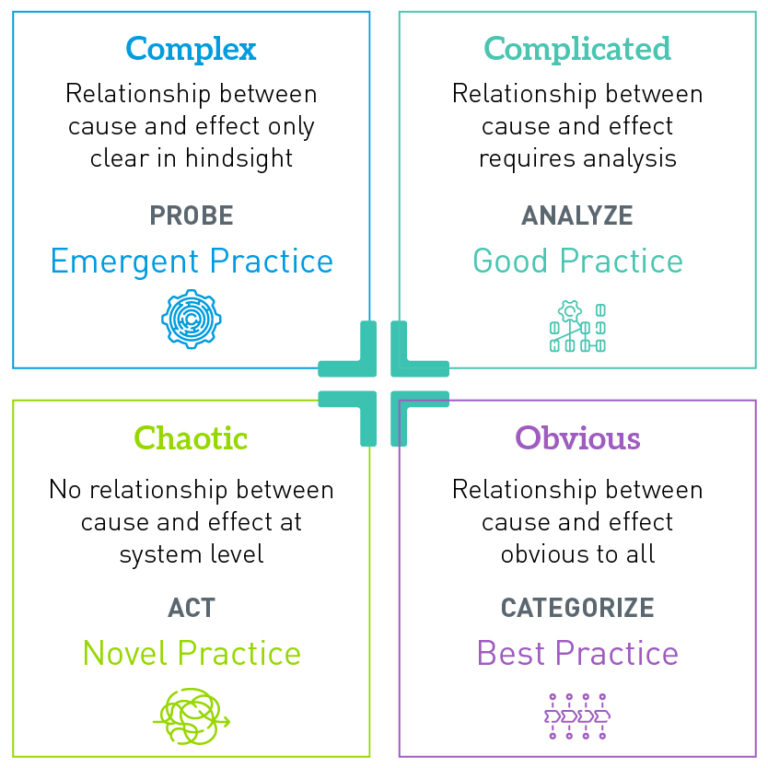Withum’s clients hire us because they need to solve problems, and technology is just one tool used to do so. Why is it that so often, when the problem changes, the tasks change, but the management methodology stays the same?
It’s easy to learn about one type of methodology and stick with it no matter what the problem. People use Waterfall project management or have switched to some form of SCRUM if they want to do an agile method. However, most people don’t ask themselves if these agile project management methodologies will best manage the problem they are trying to solve. During my SCRUM Master certification, my instructor, Aakash Srinivasan, introduced the Cynefin framework and how it can be used to identify an appropriate framework.
The idea behind using the Cynefin framework is that it helps categorize the type of problem you are dealing with to better understand it and therefore manage it.
Let’s start with what the Cynefin Framework matrix is:

The matrix provides five domains to identify a problem:
- Obvious
- Complicated
- Complex
- Chaotic
- Unknown (not called out in the above diagram)
Let’s break these down by the left and right half of the diagram.
Right-Side Quadrants
The two right-side quadrants are considered ordered/predictable because the relationship between cause and effect is known or can be discovered.
Obvious Domain (Known Knowns)
The situation is stable, there are rules in place and the relationship between cause and effect is clear and repeatable.
This is the world of “best practice.” These problems have been frequently encountered before and therefore are easy to identify and resolve.
Approach for solving these problems:
- Sense - Identify the facts about the problem
- Categorize - Categorize the problem based on the facts
- Respond - Respond based on established best practices for that problem
Complicated Domain (Known Unknowns)
The relationship between cause and effect requires analysis or expertise. There is a range of right answers.
This is the world of “good practice.” These problems have been encountered before, but they require a special skill set or time to analyze to resolve.
Approach for solving these problems:
- Sense - Identify the facts about the problem
- Analyze - Analyze the various aspects of the problem
- Respond - Respond by performing the appropriate good operating practice
Left-Side Quadrants
The two left-side quadrants are considered unordered/unpredictable because the relationship between cause and effect is not known or can’t be discovered.
Complex Domain (Unknown Unknowns)
The relationship between cause and effect can only be deduced in retrospect.
No matter how much time you spend in analysis, it is not possible to identify the risks or accurately predict the solution or effort required to solve the problem.
Everyday Kanban
This is the world of “emergent practice.” These problems oftentimes have never been encountered or not in their current form. As a result, the solution emerges as progress is made.
Approach for solving these problems:
- Probe - Try out different experiments to gather more knowledge
- Sense - Gather knowledge based on the results of the experiments
- Respond - Adjust the experiments based on the knowledge gained previously
Chaotic Domain (No Cool Analogy)
The relationship between cause and effect is unclear, even in retrospect. It’s also possible there is no relationship.
This is the world of “novel practice” (new or interesting). These problems are crises or emergency situations. They require finding stability.
Approach for solving these problems:
- Act - Act to establish order
- Sense - Sense where stability lies
- Respond - Turn the problem into a Complex problem
Note: If you move from the obvious domain to the chaotic domain, it will be very challenging to go back straight to the obvious domain. You’ll need to work your way through all other domains.
Unknown Domain
The problem doesn’t fall into a specific domain.
What Project Management Methodology Should I Use?
Now that we all have a baseline understanding of the Cynefin framework, let’s talk about how it can help in deciding what agile project management methodology to use. Due to the particularities of each domain, a methodology’s strengths should be able to deal with the challenges brought by the domain. This is where Aakash’s idea makes so much sense.
Below are examples for each domain:
- Obvious - Waterfall
- Everything is known about the problem, what tasks need to be completed and how long they will take. This fits great with the methodology built around a very specific scope, estimates and task order.
- Complicated - KanBan, DAD (Disciplined Agile Delivery), Lean
- These methodologies work well when the tasks are known; we have estimates for their duration and a general order of when things should be done.
- Complex - SCRUM
- SCRUM excels in dealing with problems that don't have a clear path and constantly change. For example, users can gravitate towards specific features, requiring a quick redirection from the product team to focus on them. Complex problems require hindsight to identify the relationship between cause and effect. SCRUM has a built-in mechanism to capture insights through its ceremonies.
When figuring out which agile project management methodology to choose, I’ve found the most beneficial part of the Cynefin framework is that it gets me thinking about the type of problem that needs to be solved. Keeping this in mind during the project helps guide adjustments that might be needed during a long project.
Contact Us
Managing a complex project soon? Reach out to a member of Withum’s Digital and Transformation Services Team today and see how your first steps can be the most important.



